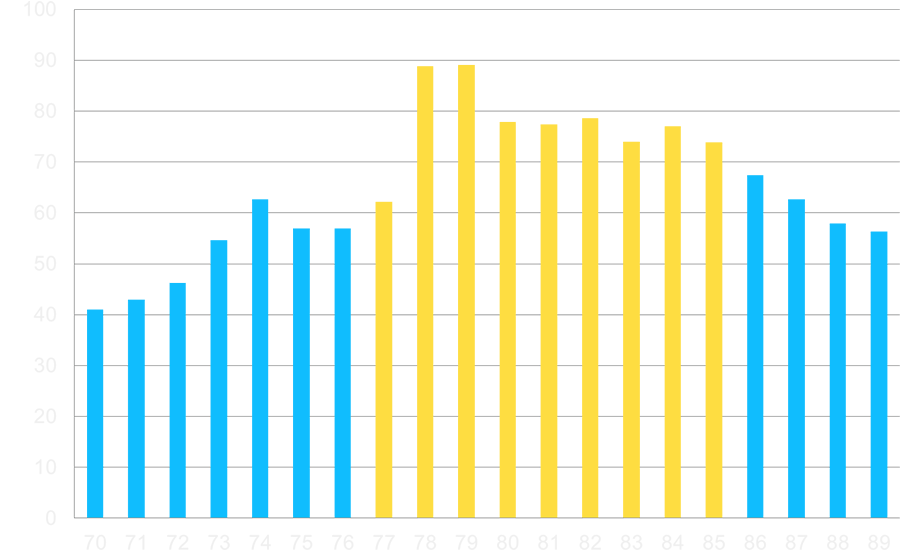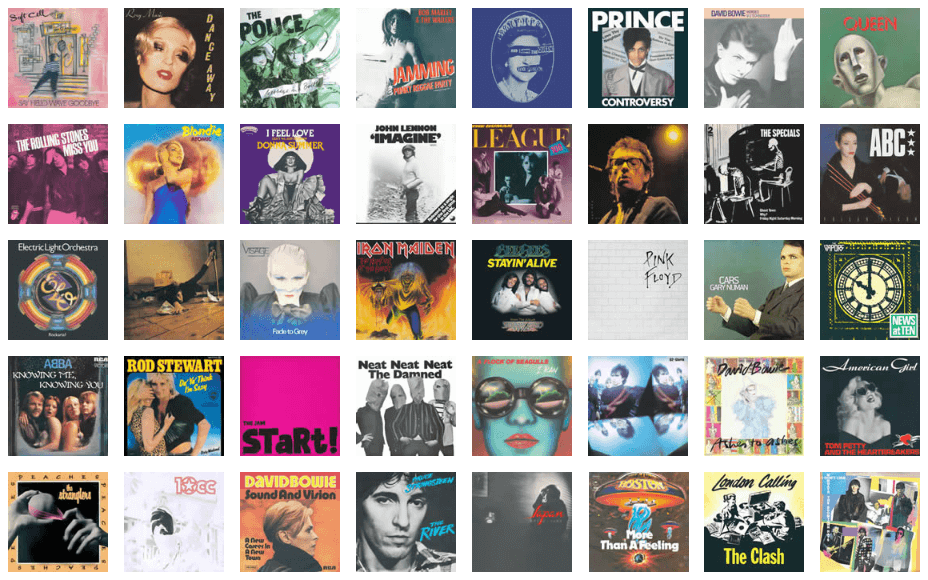About The Golden Years
Every era and year has great music, so what is so special about the nine years from 1977 to 1985, the period we call the Golden Years? The short answer is that these years saw the highest single sales; an explosion in cover art, coloured vinyl, picture discs and promotional videos; the introduction of the 12” single; and – most importantly – unprecedented quality, originality and variety of songs.
Highest Single Sales
Based on this objective measure alone, it would be warranted to say that 1977-85 are the Golden Years of the British Single. The top eight years of vinyl singles sales all occur in this nine year period, including the 89M shifted during 1979, the highest-ever volume of singles sold in a calendar year (see graph).
After 1984, vinyl singles declined every year for the rest of the century, with the early 1990s seeing volumes halve as the CD single flourished. The only "golden year" that falls outside of the Top Ten of annual singles sales is 1977, although it is still the 13th best-ever. It is included because it saw other significant events in the history of the single.
Vinyl Single Sales 1970-89

Cover Art
Of the billion singles sold in the UK between 1953 and 1976, the overwhelming majority were wrapped in a generic record company sleeve. Two reasons saw this trend change in 1977. The first was the advent of punk, which was defined more by a do-it-yourself attitude than a particular music style. This led to the formation of many independent record labels that often marketed their singles with eye-catching picture sleeves. Indeed, the cover art was sometimes as much a statement as the song.
Second, product packaging was increasingly important, a trend not confined to the record industry, and inevitably the days of the plain sleeve were numbered. A good barometer of the trend is ELO: the group’s first seven singles (1972-1976) were released in plain sleeves until Rockaria (1977) became the group's first picture cover. By 1985, the pendulum had swung; the overwhelming majority of chart singles were packaged in glossy picture covers.

Coloured and Picture Discs
The sleeve was not the only change: the actual disc became more attractive, too. There was a surprising joy in seeing your favourite single in a vibrant colour. Although the first coloured 7” was pressed as long ago as 1949 (Texarkana Baby by Eddy Arnold in green vinyl), the first half of the Golden Years saw increasing numbers of singles liven up the turntable in almost every imaginable colour, usually for limited editions. This was soon outdone by the introduction of the picture disc, which often placed the cover art or an image of the artist on the record itself. My Best Friend's Girl by The Cars in late 1978 was the first in the UK. Six months later, Tubeway Army was the first UK No. 1 to be released as a picture disc.
Video Age
the Golden Years also witnessed an even more significant trend that had nothing to do with the vinyl itself – the rise of the video. These had been made before but often simply showed the artist performing the song on stage. This all changed in the late 1970s when groups started to create more imaginative videos. For example, Walking On The Moon by The Police was filmed at the Kennedy Space Centre with drummer Stuart Copeland hitting his sticks against the enormous engines of the Saturn V rocket. Although hardly ground-breaking, it provided a different visual, and the Floridian blue sky was a welcome respite during the dark nights of winter 1979.
Of all the videos produced around this time, we would cite Another Brick In The Wall by Pink Floyd (December 1979) as arguably the one that lit the touchpaper to the video boom of the early 1980s. The group did not appear in the video and it was also one of the first to utilise animation. It showed that a video could generate word of mouth in its own right and, more importantly, a song was no longer purely aural; it was visual. Two other early videos completed the transition to music and vision: Ashes To Ashes by David Bowie (August 1980) and Vienna by Ultravox (March 1981).

Quality, Originality and Variety
The high volume of singles sales during the Golden Years was driven by mainstream pop music, especially the phenomenal success of disco in the late 1970s. Yet any impartial judgement must conclude that these years also witnessed the greatest variety in the history of our popular culture: disco, punk, new wave, reggae, rap, electronic, synth pop, rock, ska, heavy metal and hip hop are just a few. And the originality and quality of the songs also reached an all-time high. From Stayin' Alive to God Save The Queen, from Baker Street to Are 'Friends' Electric?, from Ghost Town to Tainted Love, from The Number Of The Beast to The Message, some of the finest singles of these varied genres were released during this period.
Extended Mixes
Prior to 1977, a vinyl single came in one size only: the 7" disc. In January 1977, a little-known American trio called The Undisputed Truth released their 11-minute funky-soul extravaganza You + Me = Love. Nobody is quite sure where it was found in the typical record store because it looked like an album, but when it crept into the official Top 50 it became the first 12” single to chart in the UK. Fast forward to 28 September 1985. For the first time, every Top 75 Single was available as a 12” version. In a little under nine years, a rarity had become ubiquitous. If this date represents the furthest expansion of the vinyl empire, a month later its decline began.

The Digital Omen
At the end of October 1985, Brothers In Arms by Dire Straits became the first CD single. The vinyl disc now had a digital rival, one that would effectively strangle it in as little as six years. It is also fitting that Dire Straits should be the group to release it. Their whole ethos was a reaction to punk, the genre that helped “the big bang” in British music eight years previously. And although great music was still being produced in the 1980s and 1990s, it seems entirely appropriate to say the Golden Years of the vinyl single ended at the close of 1985.
Vintage Culture
If we had to single out one year as the premier cru of British pop music we would say 1979, a year that DJ John Peel said “was never bettered”. Yet all the years between 1977 and 1985 represent the finest vintage for popular music in the UK – at least in terms of the little vinyl disc. Only now, after suffering the Cowelling of popular music into a deformed, commercial prescription of covers and second-rate songs, do we realise what we had then. And it is almost certain we will never experience it again. These were truly the Golden Years of the British single.


